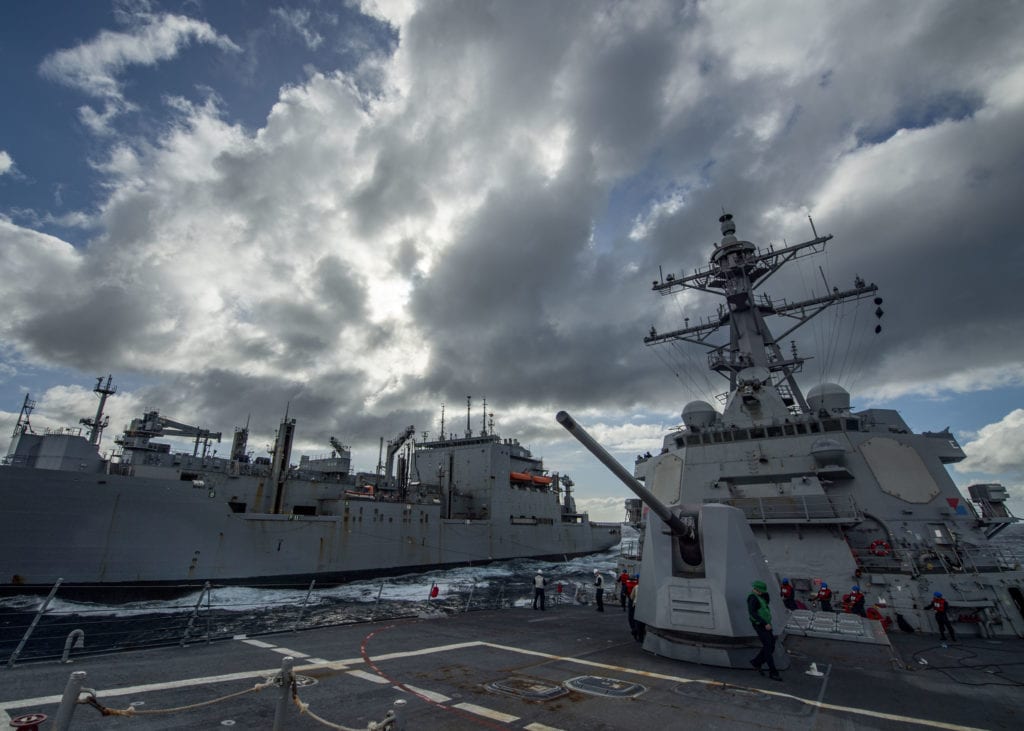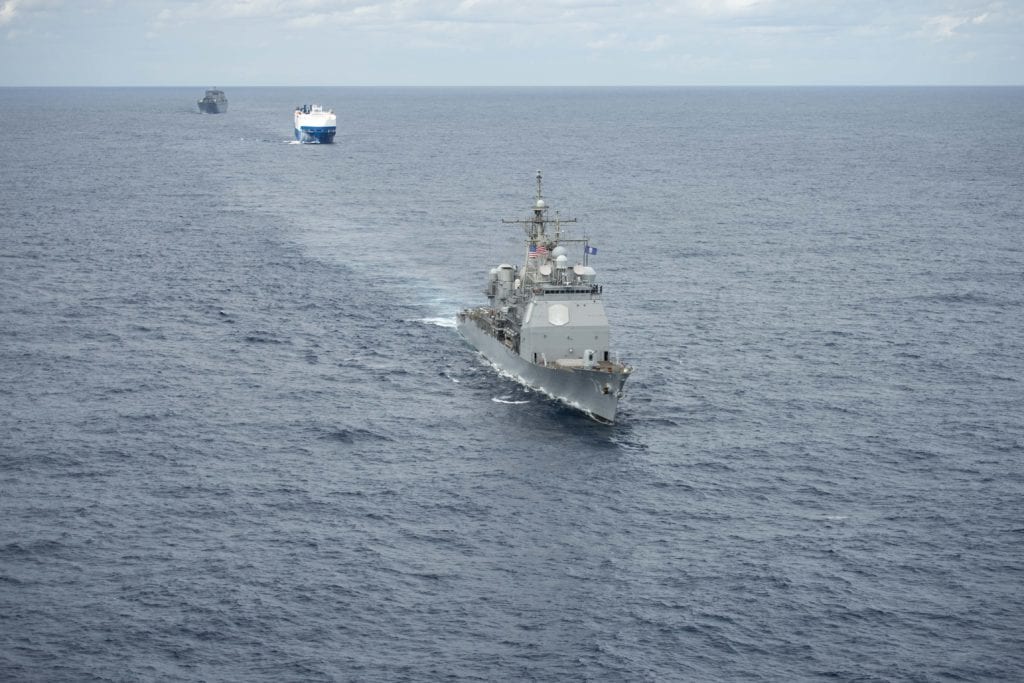
Last December, then-Navy Secretary Kenneth J. Braithwaite announced plans to bring back the U.S. Atlantic Fleet in a name change that was a deliberate message to the world — in particular the near-peer competitor nations of Russia and China as well as U.S allies — that the Atlantic Ocean and Arctic region were no longer quiet naval backwaters but areas of intense U.S. geopolitical focus.
The previous month, Braithwaite also announced plans to establish another numbered fleet for the Navy — the U.S. 1st Fleet — adding it to the seven other numbered fleets that are the main operational arms of the U.S. Navy. The service, which waged the Cold War with only four numbered fleets, has added three numbered fleets since then.
Chief of Naval Operations Adm. Mike Gilday said on Jan. 11 in a webinar of the Surface Navy Association convention that then-President Donald Trump signed off on Braithwaite’s proposed redesignation of U.S. Fleet Forces Command as the U.S. Atlantic Fleet. A timetable for the change has not been announced, but Fleet Forces Commander Adm. Chris Grady is “putting together an implementation plan for my review,” Gilday said.
Venerable Pedigree
The original U.S. Atlantic Fleet has a long pedigree that began in 1906, when the North Atlantic Squadron and South Atlantic Squadron were combined. The fleet existed in various forms until 2006, when the chief of naval operations renamed commander, U.S. Atlantic Fleet, to commander, U.S. Fleet Forces Command, which assumed the duties of the former fleet plus the mission of the former commander, Fleet Forces Command, which was “to serve as the primary advocate for fleet personnel, training, requirements, maintenance and operations issues,” according to the Fleet Forces Command website.
Sailors who had served in both Atlantic and Pacific Fleets often expressed the notion that the two fleets were like two different navies in their policies, traditions and the way they operated. The role of Fleet Forces Command in part was to standardize administration, manning, training and equipping across the entire U.S. fleet.
The move to the return of the Atlantic Fleet moniker was deliberate. Braithwaite announced the redesignation plan Dec. 2 during testimony before the Senate Armed Services Committee’s Readiness and Management Support sub- committee, noting the changing world requires the Navy to evolve to meet the threat.
“Our existing structure operates on the premise that we still live in a post-9/11 state, where NATO’s flanks are secure, the Russian fleet is tied to the pier and terrorism is our biggest problem,” Braithwaite said. “That is not the world of today. As the world changes, we must be bold, evolved and change with it. Instead of perpetuating a structure designed to support Joint Forces Command, we are aligning to today’s threat.
“To meet the maritime challenges of the Atlantic theater, we will rename Fleet Forces Command as the U.S. Atlantic Fleet and will refocus our naval forces in this important region on their original mission, to controlling the maritime approaches to the United States and those of our allies. The Atlantic Fleet will confront the re-assertive Russian navy, which has been deploying closer and closer to our East Coast with a tailored maritime presence, capability and lethality,” Braithwaite said.
“It underscores the importance of the Atlantic in a way that the title ‘Fleet Forces’ doesn’t,” Gilday said. “It actually is a testament to recent tangible decisions that we made to increase our power in that body of water, to include bringing 2nd Fleet back, standing up SubGru 2 [Submarine Group Two]. It will also include standing up [NATO’s] Joint Force Command Norfolk, which is focused on the Atlantic. In a day and age when the homeland is no longer a sanctuary and homeland defense is at the fore of every plan the combatant commanders have put together, the name ‘Atlantic Fleet’ always carries some gravitas with respect to defense of the nation.”
He noted the complexity of the redesignation, saying the command “also has responsibilities as a component [command] for [U.S.] Northern Command and the Eastern Pacific that extend up to the Arctic as well as their role as component of the [U.S] Strategic Command. They really have a global responsibility with respect to the command and control of our SSBNs [ballistic-missile submarines].”
Grady seconded the complexity in a Jan. 13 webinar at the convention, noting the “downside “might be that we would lose emphasis on what we do for the homeland.
Indeed, I control forces in both the Pacific and down south [in U.S. Southern Command area of responsibility]. So, we will balance all that, and in the end the name change is an important branding opportunity, and we will move out on that.”
“We are walking through this very methodically and deliberately before we finally execute,” Gilday said.

U.S. 1st Fleet Returning?
Braithwaite, noting the increasing Chinese hegemony in the South China Sea, the increasingly close relationship of the U.S. Navy to the Indian navy and the expanse of ocean covered by the Japan-based U.S. 7th Fleet, proposed a new fleet to cover Southeast Asia and the Indian Ocean, an area of extensive shipping traffic vital to world commerce.
“If we’re really going to have an INDOPACOM [U.S. Indo-Pacific Command] footprint, we can’t just rely on the 7th Fleet in Japan,” Braithwaite said during a Nov. 17 to webinar of the annual symposium of the Naval Submarine League. “We have to look to our other allies and partners like Singapore, like India, and actually put a numbered fleet where it would be extremely relevant if, God forbid, we were to get in any kind of a dust-up.”
Braithwaite proposed the new fleet be designated the U.S. 1st Fleet, a resurrection of a fleet staff which formerly was based in San Diego and disestablished in 1973 when the U.S. 3rd Fleet was established in Hawaii. (The 3rd Fleet headquarters later was moved to San Diego.)
He mentioned Singapore as a possible site for a headquarters for the U.S. 1st Fleet. The Navy has a logistics group staged there and has forward-deployed littoral combat ships to the base. As an alternative, the 1st Fleet staff could be “more expeditionary oriented and move it across the Pacific until it is where our allies and partners see that it could best assist them as well as assist us.”
“The establishment of 1st Fleet is still in development,” said Capt. Jereal Dorsey, special assistant for Public Affairs for the secretary of the Navy, in a Jan. 29 statement to Seapower.
“Establishing a new fleet dedicated to the Indian Ocean is a good idea,” said Bryan Clark, a senior fellow at the Hudson Institute. “India is a longtime maritime power that is modernizing its fleet and growing its cooperation with the U.S. Navy and the rest of the ‘Quad’ [Japan, Australia, United Stated, India]. A key question for the Navy to address is the area of responsibility for 1st Fleet. Incorporating East and South Africa in 1st Fleet rather than Naval Forces Europe and 6th Fleet, as they are today, would be a good idea because in many cases these countries have stronger ties to Asian countries than to Europe.
“I think including Australia or Southeast Asian nations under 1st Fleet would, in general, be disadvantageous because of the numerous maritime cooperation initiatives underway between these navies and those of the United States and Japan. However, the fleet has to be based some- where, so Myanmar, Singapore, and Malaysia could be included in 1st Fleet if the fleet were based in Singapore.
“The more important issue is whether 1st Fleet will have a substantial naval presence or any permanently assigned ships. Every other fleet has both. Adding a 1st Fleet but then only deploying forces to it in transit or for exercises may defeat the purpose of having a dedicated staff focused on the region. When the LCS [littoral combat ship] is ready for more sustained deployments, the Navy could implement the rotational crewing concept it intended in Singapore, providing assigned ships to 1st Fleet that would change out every year to 18 months. To increase presence, DoD [Department of Defense] could adjust its Central Command footprint to use locally based air, ground, and naval forces to deter Iran and allow other ships to deploy more broadly throughout the Indian Ocean.”
Changing Realities
The expansion of numbered fleets since the Cold War may seem counterintuitive with the much-shrunken size of the U.S. fleet since 1991, now roughly half the size in terms of numbers of ships. During the Cold War, the 1st and later the 3rd Fleet covered the Eastern Pacific, including the antisubmarine patrols to counter the patrolling Soviet ballistic-missile submarines off the U.S. West Coast. The 7th Fleet covered the Western Pacific and Indian Oceans. The 6th Fleet patrolled the Mediterranean. The 2nd Fleet covered the North Atlantic Ocean.
Since the end of the Cold War, the Navy has disestablished and reestablished the 2nd Fleet and has reestablished the 4th, 5th and 10th Fleets, dormant since the early post- World War II period, to adjust to changing geopolitical realities. The 5th Fleet was established to replace the Middle Eastern Force in the Persian Gulf in July 1995 in recognition of the increased need for forces in the volatile Gulf, Southwest Asia and the North Arabian Sea, and became the naval component of U.S. Central Command. The 4th Fleet was reestablished in July 2008, to serve as the naval component of U.S. Southern Command, to operate in the Caribbean Sea, and in Central and South America.
The 10th Fleet, which in World War II oversaw the campaign against German U-boats in the Battle of the Atlantic, was reestablished in July 2010 as the operational arm of Fleet Cyber Command. It commands no ships but oversees the operations of the cyber teams and other units for information warfare operations, including cyberwarfare and signals intelligence collection.
During September 2011, the 2nd Fleet was disestablished in recognition of the reduction of threats in the North Atlantic in the post-Cold War era. But with the resurgence of Russia and in particular its submarine forces, the 2nd Fleet was reestablished in August 2018.
Seapower correspondent John Doyle contributed to this report.
- Insitu Going Strong at 30, Focusing on Maritime Operations - April 8, 2024
- Navy Awards Boeing Additional Funds for MQ-25 Drones for Testing - April 3, 2024
- Benign 4th Fleet AOR Useful for Unmanned Vehicle Operationalization, Admiral Says - March 27, 2024




